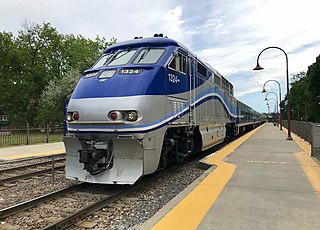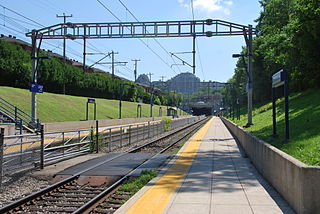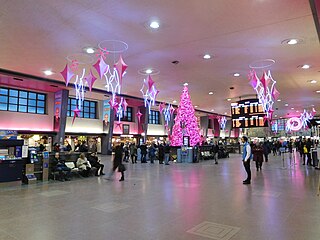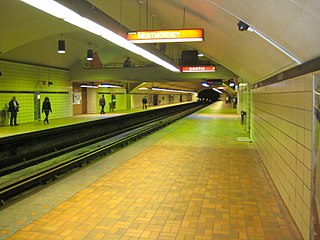
Exo, officially known as Réseau de transport métropolitain, is a public transport system in Greater Montreal, including the Island of Montreal, Laval, and communities along both the North Shore of the Mille-Îles River and the South Shore of the St. Lawrence River. It was created on June 1, 2017, taking over from the Agence métropolitaine de transport. The RTM operates Montreal's commuter rail and metropolitan bus services, and is the second busiest such system in Canada after Toronto's GO Transit. In May 2018, the former Réseau de transport métropolitain (RTM) was branded as Exo.

Vaudreuil–Hudson is a commuter railway line in Greater Montreal, Quebec, Canada. It is operated by Exo, the organization that operates public transport services across this region.

Saint-Jérôme is a commuter railway line in Greater Montreal, Quebec, Canada. It is operated by Exo, the organization that operates public transport services across this region.

Mont-Saint-Hilaire is a commuter railway line in Greater Montreal, Quebec, Canada. It is operated by Exo, the operator of public transport services across this region.

Candiac is a commuter railway line in Greater Montreal, Quebec, Canada. It is operated by Exo, the organization that operates public transport services across this region.

Canora station is a future station on the Réseau express métropolitain (REM), expected to open in the fourth quarter of 2024. It is located in the Glenmount neighbourhood of Montreal, Quebec, Canada, just east of the Town of Mount Royal. The platforms are located northwest of the west portal of the Mount Royal Tunnel.

Ville-de-Mont-Royal station is a future Réseau express métropolitain (REM) station, expected to open in 2024. It is located in Mont Royal, Quebec, about 700 metres (2,300 ft) northwest of Canora station.

Du Ruisseau station is a future Réseau express métropolitain (REM) station in Montreal, Quebec, Canada, expected to open for REM service by the end of 2024. It was formerly a commuter rail station on the Deux-Montagnes line until Exo ended service in 2020.

Bois-Franc station is a future Réseau express métropolitain (REM) interchange station in the Bois-Franc neighbourhood of Montreal, Quebec, Canada. REM service is expected to begin at the station in the fourth quarter of 2024.

Deux-Montagnes station is a future terminus station of the Réseau express métropolitain (REM) in Deux-Montagnes, Quebec, Canada. REM service at the station is scheduled to begin in the fourth quarter of 2024. The station will serve as the terminus of the Deux-Montagnes branch of the REM.

The Mount Royal Tunnel is a railway tunnel in Montreal, Quebec, Canada. The tunnel is the third longest in Canada, after the Mount Macdonald Tunnel and the Connaught Tunnel, and connects the city's Central Station, in Downtown Montreal, with the north side of Montreal Island and Laval and passes through Mount Royal.

Montreal Central Station is the major inter-city rail station and a major commuter rail hub in Montreal, Quebec, Canada. Nearly 11 million rail passengers use the station every year, making it the second-busiest train station in Canada, after Toronto Union Station.

Sainte-Dorothée was a commuter rail station operated by the Réseau de transport métropolitain (RTM) in Laval, Quebec, Canada.

Mascouche is a commuter railway line in Greater Montreal, Quebec, Canada. It is operated by Exo, the organization that operates public transport services across this region.

The Montreal Metro is a rubber-tired underground rapid transit system serving Greater Montreal, Quebec, Canada. The metro, operated by the Société de transport de Montréal (STM), was inaugurated on October 14, 1966, during the tenure of Mayor Jean Drapeau.

Dorval station is an intermodal bus and commuter rail station in Dorval, Quebec, Canada located on the Vaudreuil–Hudson line (exo1) of the Greater Montreal Exo public transport network. It is located within walking distance to inter-city rail services at Dorval Via Rail station.

The Red Line, also known as Line 3, was a proposed line of the Montreal Metro.

Sunnybrooke is a future commuter rail station operated by the Réseau de transport métropolitain (RTM) in the borough of Pierrefonds-Roxboro in Montreal, Quebec, Canada.

Roxboro-Pierrefonds in the borough of Pierrefonds-Roxboro in Montreal, Quebec, Canada is a future Réseau express métropolitain station, expected to open in 2024. It was operated by Exo in Montreal, Quebec, Canada. It was served by the Deux-Montagnes line. The station will be renamed to Pierrefonds-Roxboro when Réseau express métropolitain service commences, to match the name of the borough of Pierrefonds-Roxboro.

Sauvé station is an intermodal transit station in the borough of Ahuntsic-Cartierville in Montreal, Quebec, Canada. The Montreal Metro station is operated by the Société de transport de Montréal (STM) and serves the Orange Line. It is located in the Ahuntsic district. The station opened October 14, 1966, as part of the original network of the Metro.






















